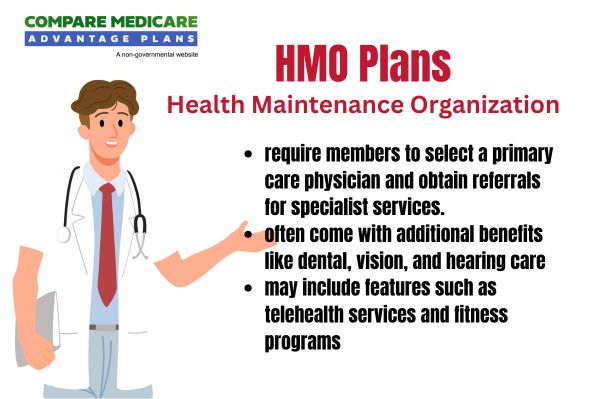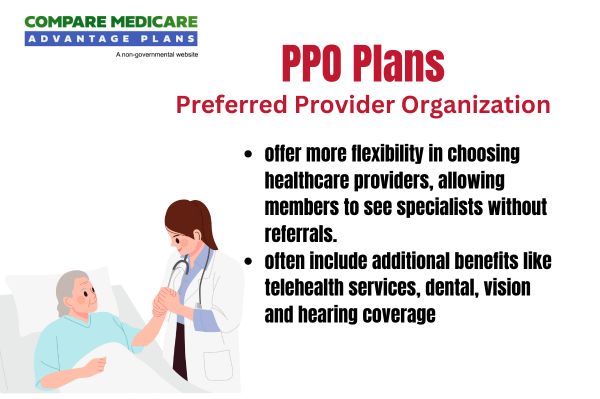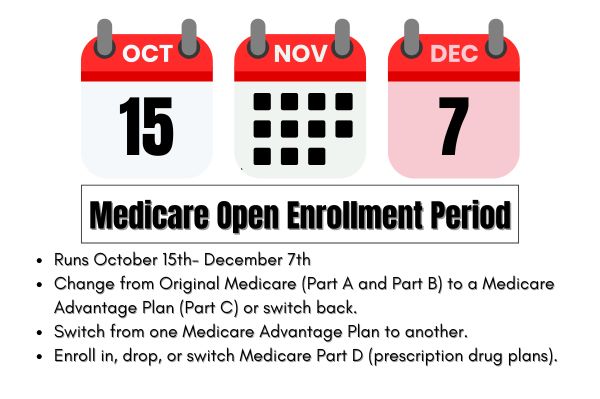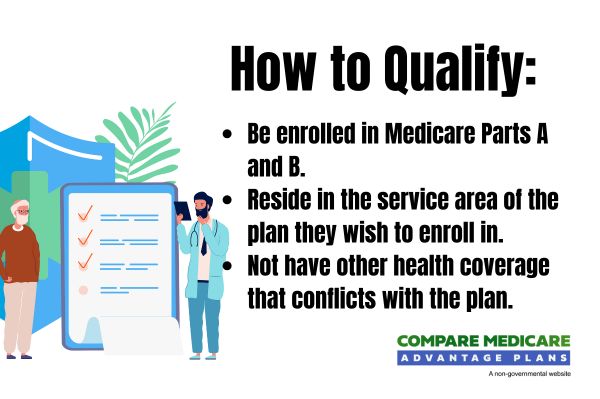




Medicare Advantage Plans Ohio 2026
Curious about the potential Medicare Advantage Plans in Ohio
Key Takeaways
- Some Ohio Medicare Advantage Plans may offer additional benefits that could go beyond Original Medicare, such as vision and dental coverage, and requires enrollment in both Medicare Parts A and B.
- The plans include various types, including HMOs, PPOs, and Special Needs Plans, each designed to meet different healthcare needs and offer varying levels of flexibility.
- Enrollment in Ohio Medicare Advantage Plans occurs during specific periods, including an Initial Enrollment Period and Annual Enrollment Period, and understanding these timelines is crucial for accessing the right coverage.
Compare Plans in One Step!
Enter Zip Code
Understanding Ohio Medicare Advantage Plans 2026

Ohio Medicare Advantage Plans could offer an alternative to traditional Medicare, occasionally providing additional benefits that aren’t covered by Original Medicare. These plans typically include both Medicare Part A and Part B coverage, ensuring comprehensive care for hospital and medical services. Some plans might incorporate additional services such as vision, hearing, and dental care, which could potentially enhance the overall healthcare experience for beneficiaries.
Eligibility for Ohio Medicare Advantage Plans requires enrollment in both Medicare Parts A and B. This dual enrollment likely ensures that beneficiaries receive a wide range of healthcare services. Additionally, most Medicare Advantage Plans in Ohio operate through a network of providers. Members may be required to use these network providers to receive full benefits, which could help keep costs lower.
Cost-sharing mechanisms such as co-pays and deductibles might vary significantly among different Ohio Medicare Advantage Plans. Understanding these details could help in selecting a plan that fits your financial and healthcare needs.
Ohio Medicare Advantage Plans will likely aim to provide more personalized and comprehensive care compared to Original Medicare. With the right plan, beneficiaries could access a broad spectrum of services tailored to their unique health needs.
Types of Ohio Medicare Advantage Plans Available
Ohio will likely offer a variety of Medicare Advantage plans to cater to different healthcare needs. These include Health Maintenance Organizations (HMOs), Preferred Provider Organizations (PPOs), and Special Needs Plans (SNPs). Each plan type comes with its own set of benefits and requirements, providing flexibility for beneficiaries to choose a plan that best suits their circumstances.
HMO Plans

HMO plans in Ohio will likely be designed to offer comprehensive and cost-effective care. Typically, members are required to select a primary care physician who will coordinate all healthcare services. This coordination could ensure that care is streamlined and that their medical needs are addressed efficiently. Referrals might be required for specialist services, encouraging a structured approach to healthcare.
One of the potential advantages of HMO plans may be the lower out-of-pocket costs. By using a network of doctors and hospitals, these plans could potentially keep costs down for members. While HMO plans generally require members to use network providers, there are exceptions for emergencies. This ensures that members could be covered regardless of where they are when an emergency occurs.
PPO Plans

PPO plans offer greater flexibility compared to HMO plans. Members can see any Medicare-approved provider without needing referrals, which could provide more freedom in choosing healthcare providers. This flexibility extends to out-of-network providers, though services outside the network might come with higher costs.
This flexibility could make PPO plans an attractive option for those who need a broader range of healthcare services. However, it’s important to note that this flexibility might come with higher premiums and out-of-pocket costs.
Despite the higher costs, PPO plans provide access to a wider network of healthcare providers, which could be particularly beneficial for those who require specialized care. The ability to see both in-network and out-of-network providers without referrals may add a significant level of convenience and choice for members.
Special Needs Plans (SNPs)

Special Needs Plans (SNPs) are tailored for specific groups, such as individuals with chronic conditions or those who are dual-eligible for Medicare and Medicaid. These plans could offer specialized care and services designed to meet the unique needs of these populations.
Overview of Ohio Medicare Advantage Plans 2026
Ohio Medicare Advantage plans could provide an alternative to Original Medicare, sometimes offering additional benefits like vision, hearing, and dental coverage. To be eligible, individuals must be enrolled in Medicare Parts A and B, which ensures comprehensive coverage for hospital and medical services. These plans are designed to provide coordinated care through networks of healthcare providers, likely making healthcare more efficient and accessible.
The Ohio Department of Insurance oversees these plans to ensure they meet state regulations and consumer protections. Residents can choose from various plan types, including HMO, PPO, and Special Needs Plans, each offering different levels of flexibility and coverage.
Potential Benefits of Ohio Medicare Advantage Plans 2026
One of the potential advantages of certain Ohio Medicare Advantage plans may be their financial accessibility. Some plans may offer lower premium, possibly making them an affordable option for many beneficiaries. Additionally, certain plans might include coverage for dental, vision, and hearing services, which are not typically offered through Original Medicare.
Ohio Medicare Advantage plans could provide comprehensive health coverage, combining the benefits of hospital, medical insurance, and sometimes prescription drug coverage under Medicare Part D. This potential integration could simplify medication management and likely ensures that beneficiaries have access to necessary medications without the hassle of managing multiple plans.
Another possible benefit might be the access to a broad national network of providers. This flexibility could enhance the options for care, allowing members to see specialists and receive treatments that might not be available within a more limited network.
Overall, Ohio Medicare Advantage plans will likely be designed to provide a comprehensive and accessible healthcare solution, likely ensuring that beneficiaries receive the care they need without breaking the bank.
Enrollment Process for Ohio Medicare Advantage Plans 2026
To enroll in a Medicare Advantage Plan in Ohio, individuals must have both Medicare Part A and Part B. Meeting this basic eligibility criterion is the first step in accessing the comprehensive benefits these plans offer.
When to Enroll

The Initial Enrollment Period for Medicare starts three months before an individual becomes eligible and lasts three months afterward. This seven-month window is crucial for enrolling in a Medicare Advantage Plan without any late penalties. Additionally, there is an Open Enrollment Period from October 15 to December 7 each year, which allows beneficiaries to join or switch plans.
For those who experience specific life events, such as moving or losing other health coverage, a Special Enrollment Period is available. This flexibility ensures that beneficiaries can enroll in or change plans to better suit their needs. Understanding these enrollment periods is essential for making timely and beneficial decisions about healthcare coverage.
Finally, the Medicare Advantage Open Enrollment Period from January 1 to March 31 allows individuals already enrolled in a Medicare Advantage Plan to switch plans or revert to Original Medicare. This period provides an additional opportunity to adjust coverage based on changing health needs or preferences.
To enroll call one of our licensed agents at 1-833-641-4938 (TTY 711), Mon-Fri 8 am-9 pm EST.
Different Enrollment Periods
Understanding the different enrollment periods for Medicare Advantage Plans is crucial for ensuring continuous and appropriate coverage. The Open Enrollment Period (OEP) runs from October 15 to December 7 each year, during which beneficiaries can join, switch, or drop a Medicare Advantage Plan. This period is the primary window for making changes to your healthcare plan without facing penalties or delays.
The Initial Enrollment Period (IEP) is another critical timeframe. This seven-month period starts three months before an individual first becomes eligible for Medicare and ends three months afterward. During this time, new beneficiaries can enroll in a Medicare Advantage Plan, ensuring they have coverage as soon as their Medicare benefits begin.
Additionally, the Medicare Advantage Open Enrollment Period from January 1 to March 31 allows those already enrolled in a Medicare Advantage Plan to switch plans or revert to Original Medicare. This flexibility ensures that beneficiaries can adjust their coverage to better meet their needs.
OEP, AEP, Special Enrollment
The Annual Enrollment Period (AEP) for Medicare Advantage plans occurs from October 15 to December 7 each year. During this time, individuals can enroll, switch, or drop their Medicare Advantage plans, making it a crucial period for reviewing and adjusting coverage options for the next year.
Special Enrollment Periods (SEPs) are available for individuals experiencing specific life events, such as moving to a new service area, losing other health coverage, or gaining Medicaid eligibility. These periods allow beneficiaries to enroll in or change their Medicare Advantage plans outside of the standard enrollment times, providing much-needed flexibility.
The Open Enrollment Period (OEP) from January 1 to March 31 allows individuals already enrolled in a Medicare Advantage Plan to switch to a different plan or return to Original Medicare. This period is essential for those who may find that their current plan no longer meets their healthcare needs or preferences.
Potential Costs Associated with Ohio Medicare Advantage Plans 2026

The potential costs associated with Ohio Medicare Advantage Plans may vary significantly depending on the specific plan and services chosen. Understanding these costs will likely be essential for selecting a plan that fits both your healthcare needs and budget.
Premiums and Co-Pays
Premiums and co-payments for Medicare Advantage plans in Ohio could differ significantly, with some services requiring low or no out-of-pocket expense and others demanding higher co-pays. This variation likely allows beneficiaries to select plans that align with their healthcare needs and financial situations.
Furthermore, the potential integration of out-of-pocket expenses may influence co-pay structures, possibly making healthcare more affordable. This potential cap could protect beneficiaries from excessive costs, likely ensuring that they could access the care they need without financial strain.
Out-of-Pocket Maximums
Out-of-pocket maximums may a critical feature of some Medicare Advantage Plans, possibly protecting beneficiaries from excessive healthcare costs. This cap could potentially ensure that once beneficiaries reach their plan’s out-of-pocket maximum, they don’t have to pay further costs for covered services for the rest of the year.
These maximums may vary by plan, so it’s essential to review the specific limits of each plan when making a selection. This potential cap could be significant benefit, likely helping to manage healthcare costs and providing peace of mind for beneficiaries.
How to Qualify for Ohio Medicare Advantage Plans 2026

Enrollment is available during the Initial Enrollment Period, which begins three months before your 65th birthday and extends three months afterward. This period is crucial for ensuring continuous coverage without any gaps. Individuals who experience life changes, such as moving or losing employer health coverage, may qualify for a Special Enrollment Period, providing additional flexibility.
Applicants must reside in the service area of the Medicare Advantage Plan they wish to join. Certain individuals may need to meet specific health condition-based eligibility criteria, particularly for Special Needs Plans, ensuring the plans are tailored to their unique needs.
Contracted Network and Access to Care
Medicare Advantage HMO plans in Ohio typically require members to use a specific network of local healthcare providers to access covered services. This network coordinates care and could potentially keeps costs low, benefiting both providers and beneficiaries. However, members of Point of Service (HMO-POS) plans could seek services outside their contracted network, albeit at a higher cost.
Preferred Provider Organization (PPO) plans offer greater flexibility, allowing members to access a broader range of providers, including those outside their network. This flexibility could be particularly beneficial for those who require specialized care or have unique healthcare needs.
Access to care in Ohio’s Medicare Advantage plans will likely be influenced by the type of plan, with some plans providing additional flexibility for out-of-network services.
Comparing Ohio Medicare Advantage Plans to Original Medicare
Some Ohio Medicare Advantage Plans may provide additional benefits not typically covered by Original Medicare, such as vision or dental care. Understanding these differences could help beneficiaries choose the best plan for their healthcare needs.
Coverage Differences
Medicare Advantage Plans might require prior authorization for certain services, unlike Original Medicare. This requirement likely ensures the services are necessary and cost-effective. Additionally, while Original Medicare does not impose yearly out-of-pocket spending limits, some Medicare Advantage Plans may offer caps on out-of-pocket expenses, possibly providing financial protection for beneficiaries.
Another potential difference could be that some Medicare Advantage Plans might include coverage for prescription drugs (Part D), whereas Original Medicare requires a separate plan for drug coverage. This potential integration could simplify the management of healthcare and medication needs, likely making it more convenient for beneficiaries.
Medicare Advantage Plans may also offer limited emergency coverage abroad, a benefit not typically available with Original Medicare. This additional coverage could be crucial for beneficiaries who travel frequently or spend part of the year outside the United States.
Cost Comparisons
Unlike Original Medicare, some Medicare Advantage Plans may include a yearly cap on out-of-pocket expenses, possibly protecting beneficiaries from high medical costs, which could be particularly advantageous for those with chronic conditions or high healthcare needs.
Medicare Advantage Plans will likely have different financial limits for in-network versus out-of-network services. Understanding these specifics is crucial as they could affect overall out-of-pocket expenses.
Some Medicare Advantage Plans may also incorporate coverage for prescription drugs (Part D), whereas Original Medicare necessitates a separate plan for drug coverage. This potential integration could simplify healthcare management and might result in cost savings for beneficiaries.
Emergencies and Referrals

In HMO plans, members typically must use network providers for services unless it is an emergency. This requirement ensures coordinated care and cost control. However, emergency care must be covered regardless of whether the provider is in-network or out-of-network, ensuring that beneficiaries receive necessary care when it matters most.
PPO plans offer greater flexibility, allowing members to seek care outside their network, often at a higher cost. Unlike HMO plans, PPO members do not need referrals for specialty services, facilitating easier access to necessary care. This flexibility could be particularly beneficial for those with complex or specialized healthcare needs.
Summary
Ohio Medicare Advantage Plans
As we look forward to
Frequently Asked Questions
→ When can I enroll in a Medicare Advantage Plan in Ohio?
You can enroll in a Medicare Advantage Plan in Ohio during the Initial Enrollment Period, which spans three months before and after you become eligible for Medicare, as well as during the Open Enrollment Period from October 15 to December 7 each year. Additionally, there’s a Medicare Advantage Open Enrollment Period from January 1 to March 31 for current enrollees looking to make changes.
→ What are the potential costs associated with Ohio Medicare Advantage Plans?
The plan details
→ What additional benefits could Ohio Medicare Advantage Plans offer?
Some Ohio Medicare Advantage Plans may offer additional benefits such as dental, vision, and hearing coverage, along with prescription drug coverage.
→ How do HMO plans differ from PPO plans in Ohio?
HMO plans in Ohio require members to use a network of providers and obtain referrals for specialists, possibly resulting in lower out-of-pocket costs, while PPO plans provide greater flexibility to see out-of-network providers without referrals, albeit often at higher costs.

ZRN Health & Financial Services, LLC, a Texas limited liability company



